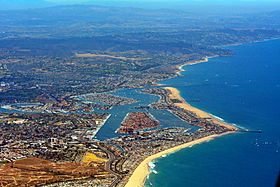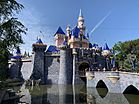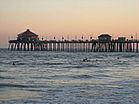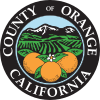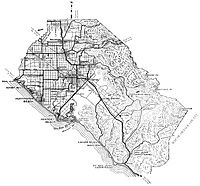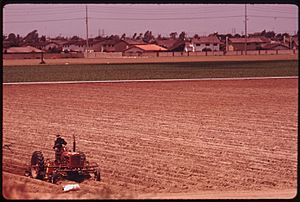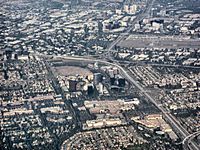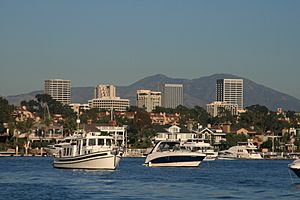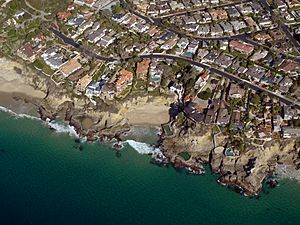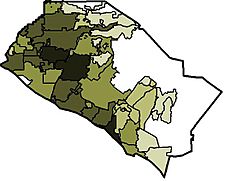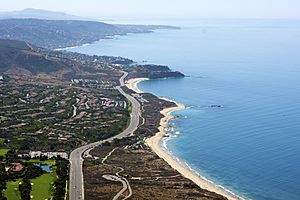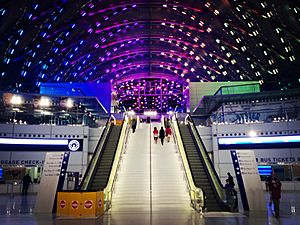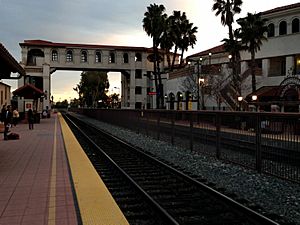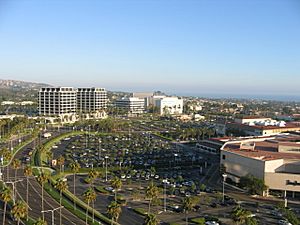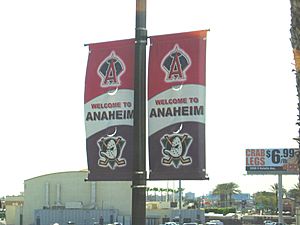Orange County, California facts for kids
Quick facts for kids
Orange County, California
|
|||
|---|---|---|---|
| County of Orange | |||
|
Images, from top down, left to right: Aerial view of the coast of Newport Beach, Sleeping Beauty Castle in Disneyland, Huntington Beach Pier, San Clemente Pier, Laguna Beach
|
|||
|
|||
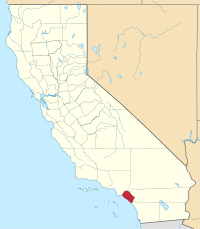
Location in the state of California
|
|||
| Country | United States | ||
| State | California | ||
| Region | Greater Los Angeles | ||
| Incorporated | August 1, 1889 | ||
| Named for | The orange, named so the county would sound like a semi-tropical, mediterranean region to people from the east coast | ||
| County seat | Santa Ana | ||
| Largest city | Anaheim | ||
| Government | |||
| • Body |
Board of Supervisors
Andrew Do
Katrina Foley Donald P. Wagner (Vice Chair) Doug Chaffee (Chair) Lisa A. Bartlett |
||
| Area | |||
| • Total | 948 sq mi (2,460 km2) | ||
| • Land | 799 sq mi (2,070 km2) | ||
| • Water | 157 sq mi (410 km2) | ||
| Highest elevation | 5,690 ft (1,730 m) | ||
| Population | |||
| • Total | 3,186,989 | ||
| • Density | 3,989/sq mi (1,540/km2) | ||
| Demonym(s) | Orange Countian | ||
| Time zone | UTC−8 (Pacific Time Zone) | ||
| • Summer (DST) | UTC−7 (Pacific Daylight Time) | ||
| Area codes | 562, 657/714, 949 | ||
| GDP | $233 billion | ||
Orange County is located in the Los Angeles metropolitan area in Southern California. As of the 2020 census, the population was 3,186,989, making it the third-most populous county in California, the sixth most populous in the U.S., and more populous than 21 U.S. states. Although largely suburban, it is the second most densely populated county in the state, behind San Francisco County. The county's three most populous cities are Anaheim, Santa Ana, and Irvine, each of which has a population exceeding 300,000. Santa Ana is also the county seat. Six cities in Orange County are on the Pacific coast, including Seal Beach, Huntington Beach, Newport Beach, Laguna Beach, Dana Point, and San Clemente.
Orange County is included in the Los Angeles-Long Beach-Anaheim Metropolitan Statistical Area. The county has 34 incorporated cities. Older cities like Santa Ana, Anaheim, Orange, and Fullerton have traditional downtowns dating back to the 19th century, while newer commercial development or "edge cities" stretch along I-5 between Disneyland and Santa Ana and between South Coast Plaza and the Irvine Business Complex, and cluster at Irvine Spectrum. Although single-family homes make up the dominant landscape for most of the county, Northern and Central Orange County is relatively more urbanized and dense as compared to those areas beyond Irvine, which are less dense, though still contiguous and primarily suburban rather than exurban.
The county is a tourist center, with attractions like Disneyland, Knott's Berry Farm, Mission San Juan Capistrano, Modjeska House, Segerstrom Center for the Arts, Yost Theater, Bowers Museum, Balboa Island, Angel Stadium, Downtown Santa Ana, the Honda Center, and several popular beaches along its more than 40 miles (64 km) of coastline. It is also home to a major research university, the University of California, Irvine (UCI), along with a number of other notable colleges and universities such as Chapman University and Cal State Fullerton.
Contents
History
Members of the Tongva, Juaneño, and Luiseño Native American groups long inhabited the area. After the 1769 expedition of Gaspar de Portolà, a Spanish expedition led by Junipero Serra named the area Valle de Santa Ana (Valley of Saint Anne). On November 1, 1776, Mission San Juan Capistrano became the area's first permanent European settlement. Among those who came with Portolá were José Manuel Nieto and José Antonio Yorba. Both these men were given land grants—Rancho Los Nietos and Rancho Santiago de Santa Ana, respectively. The Nieto heirs were granted land in 1834. The Nieto ranches were known as Rancho Los Alamitos, Rancho Las Bolsas, and Rancho Los Coyotes. Yorba heirs Bernardo Yorba and Teodosio Yorba were also granted Rancho Cañón de Santa Ana (Santa Ana Canyon Ranch) and Rancho Lomas de Santiago, respectively. Other ranchos in Orange County were granted by the Mexican government during the Mexican period in Alta California.
A severe drought in the 1860s devastated the prevailing industry, cattle ranching, and much land came into the possession of Richard O'Neill, Sr., James Irvine and other land barons. In 1887, silver was discovered in the Santa Ana Mountains, attracting settlers via the Santa Fe and Southern Pacific Railroads.
This growth led the California legislature to divide Los Angeles County and create Orange County as a separate political entity on March 11, 1889. The county is said to have been named for the citrus fruit in an attempt to promote immigration by suggesting a semi-tropical paradise–a place where anything could grow.
Other citrus crops, avocados, and oil extraction were also important to the early economy. Orange County benefited from the July 4, 1904 completion of the Pacific Electric Railway, a trolley connecting Los Angeles with Santa Ana and Newport Beach. The link made Orange County an accessible weekend retreat for celebrities of early Hollywood. It was deemed so significant that Pacific City changed its name to Huntington Beach in honor of Henry E. Huntington, president of the Pacific Electric and nephew of Collis Huntington. Transportation further improved with the completion of the State Route and U.S. Route 101 (now mostly Interstate 5) in the 1920s.
Agriculture, such as that involving the boysenberries made famous by Buena Park native Walter Knott, began to decline after World War II. However, the county's prosperity soared during this time. The completion of Interstate 5 in 1954 helped make Orange County a bedroom community for many who moved to Southern California to work in aerospace and manufacturing. Orange County received a further boost in 1955 with the opening of Disneyland.
In 1969, Yorba Linda-born Orange County native Richard Nixon became the 37th President of the United States.
In the 1980s, Orange County had become the second most populous county in California as the population topped two million for the first time.
In 1994, an investment fund meltdown led to the criminal prosecution of treasurer Robert Citron. The county lost at least $1.5 billion through high-risk investments in bonds. The loss was blamed on derivatives by some media reports. On December 6, 1994, the County of Orange declared Chapter 9 bankruptcy, from which it emerged on June 12, 1996. The Orange County bankruptcy was at the time the largest municipal bankruptcy in U.S. history.
In recent years, land use conflicts have arisen between established areas in the north and less developed areas in the south. These conflicts have regarded issues such as construction of new toll roads and the repurposing of a decommissioned air base. El Toro Marine Corps Air Station was designated by a voter measure in 1994 to be developed into an international airport to complement the existing John Wayne Airport. But subsequent voter initiatives and court actions have caused the airport plan to be permanently shelved. Instead, it will become the Orange County Great Park.
Geography
According to the U.S. Census Bureau, the county has a total area of 948 square miles (2,460 km2), of which 791 square miles (2,050 km2) is land and 157 square miles (410 km2) (16.6%) is water. It is the smallest county in Southern California. The average annual temperature is about 68 °F (20 °C).
Orange County is bordered on the southwest by the Pacific Ocean, on the north by Los Angeles County, on the northeast by San Bernardino County and Riverside County, and on the southeast by San Diego County.
The northwestern part of the county lies on the coastal plain of the Los Angeles Basin, while the southeastern end rises into the foothills of the Santa Ana Mountains. Most of Orange County's population reside in one of two shallow coastal valleys that lie in the basin, the Santa Ana Valley and the Saddleback Valley. The Santa Ana Mountains lie within the eastern boundaries of the county and of the Cleveland National Forest. The high point is Santiago Peak (5,689 feet (1,734 m)), about 20 mi (32 km) east of Santa Ana. Santiago Peak and nearby Modjeska Peak, just 200 feet (60 m) shorter, form a ridge known as Saddleback, visible from almost everywhere in the county. The Peralta Hills extend westward from the Santa Ana Mountains through the communities of Anaheim Hills, Orange, and ending in Olive. The Loma Ridge is another prominent feature, running parallel to the Santa Ana Mountains through the central part of the county, separated from the taller mountains to the east by Santiago Canyon.
The Santa Ana River is the county's principal watercourse, flowing through the middle of the county from northeast to southwest. Its major tributary to the south and east is Santiago Creek. Other watercourses within the county include Aliso Creek, San Juan Creek, and Horsethief Creek. In the North, the San Gabriel River also briefly crosses into Orange County and exits into the Pacific on the Los Angeles-Orange County line between the cities of Long Beach and Seal Beach. Laguna Beach is home to the county's only natural lakes, Laguna Lakes, which are formed by water rising up against an underground fault.
Residents sometimes divide the county into north Orange County and south Orange County. In effect, this is a division of the county into northwestern and southeastern halves following the county's natural diagonal orientation along the coast. This is more of a cultural and demographic distinction perpetuated by the popular television shows The OC, The Real Housewives of Orange County and Laguna Beach. The distinction exists between the older areas closer to Los Angeles and the more affluent and recently developed areas to the south. A transition between older and newer development may be considered to exist roughly parallel to State Route 55, also known as the Costa Mesa Freeway. This transition is accentuated by large flanking tracts of sparsely developed area occupied until recent years by agriculture and military airfields.
While there is a northeast to southwest topographic transition from elevated areas inland to the lower coastal band, there is no formal geographic division between North and South County. Perpendicular to that gradient, the Santa Ana River roughly divides the county into northwestern and southeastern sectors. Each sector comprises 40 to 60 percent of the county respectively by area. There are significant political, demographic, economic, and cultural distinctions between North and South Orange County, with North Orange County having greater populations of people of color, younger populations, greater percentages of renters, lower median incomes, higher rates of unemployment, and greater proportions of voters registered as Democrats versus as Republicans. However, certain areas in both North and South Orange County vary from these general trends.
Adjacent counties
- Los Angeles County (North).
- San Diego County (South).
- Riverside County (East).
- San Bernardino County (Northeast).
National protected areas
Demographics
| Historical population | |||
|---|---|---|---|
| Census | Pop. | %± | |
| 1890 | 13,589 | — | |
| 1900 | 19,696 | 44.9% | |
| 1910 | 34,436 | 74.8% | |
| 1920 | 61,375 | 78.2% | |
| 1930 | 118,674 | 93.4% | |
| 1940 | 130,760 | 10.2% | |
| 1950 | 216,224 | 65.4% | |
| 1960 | 703,925 | 225.6% | |
| 1970 | 1,420,386 | 101.8% | |
| 1980 | 1,932,709 | 36.1% | |
| 1990 | 2,410,556 | 24.7% | |
| 2000 | 2,846,289 | 18.1% | |
| 2010 | 3,010,232 | 5.8% | |
| 2020 | 3,186,989 | 5.9% | |
| U.S. Decennial Census 1790–1960 1900–1990 1990–2000 2010 2020 |
|||
2020 census
| Race / Ethnicity | Pop 2010 | Pop 2020 | % 2010 | % 2020 |
|---|---|---|---|---|
| White alone (NH) | 1,328,499 | 1,198,655 | 44.13% | 37.61% |
| Black or African American alone (NH) | 44,000 | 49,304 | 1.46% | 1.55% |
| Native American or Alaska Native alone (NH) | 6,216 | 5,298 | 0.21% | 0.17% |
| Asian alone (NH) | 532,477 | 699,124 | 17.69% | 21.94% |
| Pacific Islander alone (NH) | 8,357 | 7,714 | 0.28% | 0.24% |
| Some Other Race alone (NH) | 5,593 | 14,818 | 0.19% | 0.46% |
| Mixed Race/Multi-Racial (NH) | 72,117 | 125,242 | 2.40% | 3.93% |
| Hispanic or Latino (any race) | 1,012,973 | 1,086,834 | 33.65% | 34.10% |
| Total | 3,010,232 | 3,186,989 | 100.00% | 100.00% |
Note: the US Census treats Hispanic/Latino as an ethnic category. This table excludes Latinos from the racial categories and assigns them to a separate category. Hispanics/Latinos can be of any race.
2018
| Population, race, and income | |||||
|---|---|---|---|---|---|
| Total population | 3,185,968 | ||||
| White | 71.5% | ||||
| White non-Hispanic | 40.1% | ||||
| Black or African American | 2.1% | ||||
| American Indian or Alaska Native | 1.0% | ||||
| Asian | 21.4% | ||||
| Native Hawaiian or other Pacific Islander | 0.4% | ||||
| Hispanic or Latino (of any race) | 34.2% | ||||
| Per capita income 2013–7 in 2018 dollars | $37,603 | ||||
| Median household income 2013–7 in 2018 dollars | $81,851 | ||||
2011
| Population, race, and income | |||||
|---|---|---|---|---|---|
| Total population | 2,989,948 | ||||
| White | 1,852,969 | 62.0% | |||
| Black or African American | 49,513 | 1.7% | |||
| American Indian or Alaska Native | 12,548 | 0.4% | |||
| Asian | 532,499 | 17.8% | |||
| Native Hawaiian or other Pacific Islander | 9,331 | 0.3% | |||
| Hispanic or Latino (of any race) | 994,279 | 33.3% | |||
| Per capita income | $34,416 | ||||
| Median household income | $75,762 | ||||
| Median family income | $85,009 | ||||
Places by population, race, and income
| Place | Type | Population | Per capita income | Median household income | Median family income |
|---|---|---|---|---|---|
| Aliso Viejo | City | 47,037 | $44,646 | $99,095 | $113,183 |
| Anaheim | City | 335,057 | $23,109 | $59,330 | $63,180 |
| Anaheim Hills | City | 55,036 | $52,195 | $123,260 | $148,360 |
| Brea | City | 38,837 | $36,195 | $81,278 | $98,159 |
| Buena Park | City | 80,214 | $23,470 | $64,809 | $68,872 |
| Costa Mesa | City | 109,796 | $33,800 | $65,471 | $74,201 |
| Coto de Caza | CDP | 14,974 | $65,625 | $164,385 | $176,686 |
| Cypress | City | 47,610 | $32,815 | $82,954 | $92,276 |
| Dana Point | City | 33,510 | $51,431 | $83,306 | $101,186 |
| Fountain Valley | City | 55,209 | $35,487 | $81,661 | $91,003 |
| Fullerton | City | 134,079 | $30,967 | $69,432 | $78,812 |
| Garden Grove | City | 170,148 | $21,066 | $60,036 | $62,820 |
| Huntington Beach | City | 189,744 | $42,127 | $80,901 | $99,038 |
| Irvine | City | 205,057 | $43,102 | $92,599 | $109,762 |
| Ladera Ranch | CDP | 21,412 | $48,671 | $132,475 | $143,857 |
| Laguna Beach | City | 22,808 | $81,591 | $99,190 | $139,833 |
| Laguna Hills | City | 30,477 | $44,751 | $85,971 | $105,385 |
| Laguna Niguel | City | 62,855 | $51,491 | $100,480 | $119,757 |
| Laguna Woods | City | 16,276 | $36,017 | $35,393 | $50,332 |
| La Habra | City | 60,117 | $24,589 | $63,356 | $69,028 |
| Lake Forest | City | 77,111 | $39,844 | $94,632 | $108,211 |
| La Palma | City | 15,536 | $34,475 | $84,693 | $92,757 |
| Las Flores | CDP | 5,911 | $46,717 | $128,269 | $135,046 |
| Los Alamitos | City | 11,442 | $38,527 | $79,861 | $90,409 |
| Midway City | CDP | 8,052 | $18,610 | $46,714 | $55,168 |
| Mission Viejo | City | 93,076 | $41,436 | $96,420 | $109,693 |
| Newport Beach | City | 84,417 | $80,872 | $108,946 | $151,773 |
| North Tustin | CDP | 24,572 | $55,038 | $109,629 | $119,543 |
| Orange | City | 135,582 | $32,797 | $78,654 | $88,423 |
| Placentia | City | 50,089 | $30,451 | $78,364 | $90,372 |
| Rancho Santa Margarita | City | 47,769 | $41,787 | $104,167 | $116,540 |
| Rossmoor | CDP | 10,099 | $51,210 | $108,427 | $119,727 |
| San Clemente | City | 62,052 | $47,894 | $89,289 | $107,524 |
| San Juan Capistrano | City | 34,455 | $39,097 | $73,806 | $86,744 |
| Santa Ana | City | 325,517 | $16,564 | $54,399 | $53,111 |
| Seal Beach | City | 24,157 | $44,115 | $50,958 | $94,035 |
| Stanton | City | 38,141 | $20,558 | $51,933 | $53,968 |
| Sunset Beach | CDP | 1,486 | $47,415 | $68,036 | $109,125 |
| Tustin | City | 74,625 | $32,854 | $73,231 | $80,963 |
| Villa Park | City | 5,825 | $71,697 | $151,139 | $165,833 |
| Westminster | City | 89,440 | $23,201 | $56,867 | $61,145 |
| Yorba Linda | City | 63,578 | $49,485 | $115,291 | $128,528 |
2010
The 2010 United States Census reported that Orange County had a population of 3,010,232. The racial makeup of Orange County was 1,830,758 (60.8%) White (44.0% non-Hispanic white), 50,744 (1.7%) African American, 18,132 (0.6%) Native American, 537,804 (17.9%) Asian, 9,354 (0.3%) Pacific Islander, 435,641 (14.5%) from other races, and 127,799 (4.2%) from two or more races. Hispanic or Latino of any race were 1,012,973 persons (33.7%).
The Hispanic and Latino population is predominantly of Mexican origin; this group accounts for 28.5% of the county's population, followed by Salvadorans (0.8%), Guatemalans (0.5%), Puerto Ricans (0.4%), Cubans (0.3%), Colombians (0.3%), and Peruvians (0.3%). Santa Ana with its population reportedly 75 percent Hispanic/Latino, is among the most Hispanic/Latino percentage cities in both California and the U.S., esp. of Mexican-American descent.
Among the Asian population, 6.1% are Vietnamese, followed by Koreans (2.9%), Chinese (2.7%), Filipinos (2.4%), Indians (1.4%), Japanese (1.1%), Cambodians (0.2%) Pakistanis (0.2%), Thais (0.1%), Indonesians (0.1%), and Laotians (0.1%). According to KPCC in 2014, Orange County has the largest proportion of Asian Americans in Southern California, where one in five residents are Asian American. There is also a significant Muslim population in the county.
| Population reported at 2010 United States Census | |||||||||
|---|---|---|---|---|---|---|---|---|---|
|
The County
|
Total
Population |
White
|
African
American |
Native
American |
Asian
|
Pacific
Islander |
other
races |
two or
more races |
Hispanic
or Latino (of any race) |
| Orange County | 3,010,232 | 1,830,758 | 67,708 | 18,132 | 537,804 | 9,354 | 435,641 | 127,799 | 1,012,973 |
|
Total
Population |
White
|
African
American |
Native
American |
Asian
|
Pacific
Islander |
other
races |
two or
more races |
Hispanic
or Latino (of any race) |
|
| Aliso Viejo | 47,823 | 34,437 | 967 | 151 | 6,996 | 89 | 2,446 | 2,737 | 8,164 |
| Anaheim | 336,265 | 177,237 | 9,347 | 2,648 | 49,857 | 1,607 | 80,705 | 14,864 | 177,467 |
| Brea | 39,282 | 26,363 | 1,549 | 190 | 7,144 | 69 | 3,236 | 1,731 | 9,817 |
| Buena Park | 80,530 | 36,454 | 3,073 | 862 | 21,488 | 455 | 14,066 | 4,132 | 31,638 |
| Costa Mesa | 109,960 | 75,335 | 1,640 | 686 | 8,654 | 527 | 17,992 | 5,126 | 39,403 |
| Cypress | 47,802 | 26,000 | 1,444 | 289 | 14,978 | 234 | 2,497 | 2,360 | 8,779 |
| Dana Point | 33,351 | 28,701 | 294 | 229 | 1,064 | 37 | 1,952 | 1,074 | 5,662 |
| Fountain Valley | 55,313 | 31,225 | 1,510 | 229 | 18,418 | 171 | 2,445 | 2,315 | 7,250 |
| Fullerton | 135,161 | 72,845 | 4,138 | 842 | 30,788 | 321 | 21,439 | 5,788 | 46,501 |
| Garden Grove | 170,883 | 68,149 | 3,155 | 983 | 63,451 | 1,110 | 28,916 | 6,119 | 63,079 |
| Huntington Beach | 189,992 | 145,661 | 1,813 | 992 | 21,070 | 635 | 11,193 | 8,628 | 32,411 |
| Irvine | 212,375 | 107,215 | 3,868 | 355 | 83,176 | 334 | 5,867 | 11,710 | 19,621 |
| La Habra | 60,239 | 35,147 | 1,025 | 531 | 5,653 | 103 | 15,224 | 2,556 | 34,449 |
| La Palma | 15,568 | 5,762 | 802 | 56 | 7,483 | 41 | 760 | 664 | 2,487 |
| Laguna Beach | 22,723 | 20,645 | 278 | 61 | 811 | 15 | 350 | 663 | 1,650 |
| Laguna Hills | 30,344 | 22,045 | 520 | 101 | 3,829 | 58 | 2,470 | 1,421 | 6,242 |
| Laguna Niguel | 62,979 | 50,625 | 877 | 219 | 5,459 | 87 | 3,019 | 2,793 | 8,761 |
| Laguna Woods | 16,192 | 14,133 | 110 | 24 | 1,624 | 10 | 90 | 201 | 650 |
| Lake Forest | 77,264 | 54,341 | 1,695 | 384 | 10,115 | 191 | 7,267 | 3,671 | 19,024 |
| Los Alamitos | 11,449 | 8,131 | 324 | 51 | 1,471 | 50 | 726 | 696 | 2,418 |
| Mission Viejo | 93,305 | 74,493 | 1,710 | 379 | 8,462 | 153 | 4,332 | 4,276 | 15,877 |
| Newport Beach | 85,186 | 74,357 | 616 | 223 | 5,982 | 114 | 1,401 | 2,493 | 6,174 |
| Orange | 136,416 | 91,522 | 3,627 | 993 | 15,350 | 352 | 20,567 | 5,405 | 52,014 |
| Placentia | 50,533 | 31,373 | 914 | 386 | 7,531 | 74 | 8,247 | 2,008 | 18,416 |
| Rancho Santa Margarita | 47,853 | 37,421 | 887 | 182 | 4,350 | 102 | 2,674 | 2,237 | 8,902 |
| San Clemente | 63,522 | 54,605 | 511 | 363 | 2,333 | 90 | 3,433 | 2,287 | 10,702 |
| San Juan Capistrano | 34,593 | 26,664 | 293 | 286 | 975 | 33 | 5,234 | 1,208 | 13,388 |
| Santa Ana | 324,528 | 148,838 | 6,356 | 3,260 | 34,138 | 976 | 120,789 | 11,671 | 253,928 |
| Seal Beach | 24,168 | 20,154 | 279 | 65 | 2,309 | 58 | 453 | 850 | 2,331 |
| Stanton | 38,186 | 16,991 | 3,358 | 405 | 8,831 | 217 | 9,274 | 1,610 | 19,417 |
| Tustin | 75,540 | 39,729 | 2,722 | 442 | 15,299 | 268 | 14,499 | 3,581 | 30,024 |
| Villa Park | 5,812 | 4,550 | 92 | 34 | 854 | 1 | 162 | 169 | 598 |
| Westminster | 89,701 | 32,037 | 2,849 | 397 | 42,597 | 361 | 10,229 | 3,231 | 21,176 |
| Yorba Linda | 64,234 | 48,246 | 835 | 230 | 10,030 | 85 | 2,256 | 2,552 | 9,220 |
|
Total
Population |
White
|
African
American |
Native
American |
Asian
|
Pacific
Islander |
other
races |
two or
more races |
Hispanic
or Latino (of any race) |
|
| Coto de Caza | 14,866 | 13,094 | 132 | 26 | 878 | 20 | 174 | 542 | 1,170 |
| Ladera Ranch | 22,980 | 17,899 | 335 | 54 | 2,774 | 27 | 624 | 1,267 | 2,952 |
| Las Flores | 5,971 | 4,488 | 91 | 23 | 780 | 12 | 261 | 316 | 984 |
| Midway City | 8,485 | 2,884 | 71 | 65 | 3,994 | 40 | 1,165 | 266 | 2,467 |
| North Tustin | 24,917 | 20,836 | 148 | 104 | 1,994 | 52 | 908 | 875 | 3,260 |
| Rossmoor | 10,244 | 8,691 | 84 | 36 | 838 | 29 | 168 | 398 | 1,174 |
|
Other
unincorporated areas |
Total
Population |
White
|
African
American |
Native
American |
Asian
|
Pacific
Islander |
other
races |
two or
more races |
Hispanic
or Latino (of any race) |
| All others not CDPs (combined) | 32,726 | 20,572 | 4,365 | 290 | 3,934 | 144 | 6,113 | 1,272 | 13,247 |
2000
As of the census of 2000, there were 2,846,289 people, 935,287 households, and 667,794 families living in the county, making Orange County the second most populous county in California. The population density was 1,392/km2 (3,606/sq mi). There were 969,484 housing units at an average density of 474/km2 (1,228/sq mi). The racial makeup of the county was 64.8% White, 13.6% Asian, 1.7% African American, 0.7% Native American, 0.3% Pacific Islander, 14.8% from other races, and 4.1% from two or more races. 30.8% were Hispanic or Latino of any race. 8.9% were of German, 6.9% English and 6.0% Irish ancestry according to Census 2000. 58.6% spoke only English at home; 25.3% spoke Spanish, 4.7% Vietnamese, 1.9% Korean, 1.5% Chinese (Cantonese or Mandarin) and 1.2% Tagalog.
In 1990, still according to the census there were 2,410,556 people living in the county. The racial makeup of the county was 78.6% White, 10.3% Asian or Pacific Islander, 1.8% African American, 0.5% Native American, and 8.8% from other races. 23.4% were Hispanic or Latino of any race.
Out of 935,287 households, 37.0% had children under the age of 18 living with them, 55.9% married couples were living together, 10.7% had a female householder with no husband present, and 28.6% were non-families. 21.1% of all households were made up of individuals, and 7.2% had someone living alone who was 65 years of age or older. The average household size was 3.00 and the average family size was 3.48.
Ethnic change has been transforming the population. By 2009, nearly 45 percent of the residents spoke a language other than English at home. Whites now comprise only 45 percent of the population, while the numbers of Hispanics grow steadily, along with Vietnamese, Korean and Chinese families. The percentage of foreign-born residents jumped to 30 percent in 2008 from 6 percent in 1970. The mayor of Irvine, Sukhee Kang, was born in Korea, making him the first Korean-American to run a major American city. “We have 35 languages spoken in our city,” Kang observed. The population is diverse age-wise, with 27.0% under the age of 18, 9.4% from 18 to 24, 33.2% from 25 to 44, 20.6% from 45 to 64, and 9.9% 65 years of age or older. The median age is 33 years. For every 100 females, there were 99.0 males. For every 100 females age 18 and over, there were 96.7 males.
The median income for a household in the county was $61,899, and the median income for a family was $75,700 (these figures had risen to $71,601 and $81,260 respectively as of a 2007 estimate). Males had a median income of $45,059 versus $34,026 for females. The per capita income for the county was $25,826. About 7.0% of families and 10.3% of the population were below the poverty line, including 13.2% of those under age 18 and 6.2% of those age 65 or over.
Residents of Orange County are known as "Orange Countians".
Transportation
Transit in Orange County is offered primarily by the Orange County Transportation Authority. The American Public Transportation Association (APTA) cited OCTA as the best large public transportation system in the United States for 2005. OCTA manages the county's bus network and funds the construction and maintenance of local streets, highways, and freeways; regulates taxicab services; maintains express toll lanes through the median of California State Route 91; and works with Southern California's Metrolink to provide commuter rail service along three lines: the Orange County Line, the 91 Line, and the Inland Empire–Orange County Line.
Major highways
Ground transportation in Orange County relies heavily on three major interstate highways: the Santa Ana Freeway (I-5), the San Diego Freeway (I-405 and I-5 south of Irvine), and the San Gabriel River Freeway (I-605), which briefly passes through northwestern Orange County. The other freeways in the county are state highways, and include the Riverside and Artesia Freeway (SR 91) and the Garden Grove Freeway (SR 22) running east–west, and the Orange Freeway (SR 57), the Costa Mesa Freeway (SR 55), the Laguna Freeway (SR 133), the San Joaquin Transportation Corridor (SR 73), the Eastern Transportation Corridor (SR 261, SR 133, SR 241), and the Foothill Transportation Corridor (SR 241) running north–south. Minor stub freeways include the Richard M. Nixon Freeway (SR 90), also known as Imperial Highway, and the southern terminus of Pacific Coast Highway (SR 1). There are no U.S. Highways in Orange County, though two existed in the county until the mid-1960s: 91 and 101. US 91 went through what is now the state route of the same number, and US 101 was replaced by Interstate 5. SR 1 was once a bypass of US 101 (Route 101A).
 Interstate 5
Interstate 5 Interstate 405
Interstate 405 Interstate 605
Interstate 605 State Route 1
State Route 1 State Route 22
State Route 22 State Route 39
State Route 39 State Route 55
State Route 55 State Route 57
State Route 57 State Route 72
State Route 72 State Route 73
State Route 73 State Route 74
State Route 74 State Route 90
State Route 90 State Route 91
State Route 91 State Route 133
State Route 133 State Route 142
State Route 142 State Route 241
State Route 241 State Route 261
State Route 261
Bus
The bus network comprises 6,542 stops on 77 lines, running along most major streets, and accounts for 210,000 boardings a day. The fleet of 817 buses is gradually being replaced by CNG (Compressed natural gas)-powered vehicles, which already represent over 40% of the total fleet. Service is operated by OCTA employees and First Transit under contract. OCTA operates one bus rapid transit service, Bravo, on Harbor Boulevard. In addition, OCTA offers paratransit service for the disabled, also operated by MV.
Rail
Since 1992, Metrolink has operated three commuter rail lines through Orange County, and has also maintained Rail-to-Rail service with parallel Amtrak service. On a typical weekday, over 40 trains run along the Orange County Line, the 91 Line and the Inland Empire–Orange County Line. Along with Metrolink riders on parallel Amtrak lines, these lines generate approximately 15,000 boardings per weekday. Metrolink also began offering weekend service on the Orange County Line and the Inland Empire-Orange County line in the summer of 2006. As ridership has steadily increased in the region, new stations have opened at Anaheim Canyon, Buena Park, Tustin, and Laguna Niguel/Mission Viejo. Plans for a future station in Placentia are underway and is expected to be completed by 2020.
Since 1938, the Atchison, Topeka, and Santa Fe Railroad and later Amtrak, has operated the Pacific Surfliner regional passenger train route (previously named the San Diegan until 2000) through Orange County. The route includes stops at eight stations in Orange County including, in northbound order, San Clemente Pier (selected trips), San Juan Capistrano, Laguna Niguel/Mission Viejo (selected trips), Irvine, Santa Ana, Orange (selected trips), Anaheim Regional Transportation Intermodal Center (ARTIC), and Fullerton Transportation Center.
OC Streetcar, formerly known as the Santa Ana/Garden Grove Fixed Guideway Project, is a streetcar line connecting Downtown Santa Ana to the Depot at Santa Ana which is currently under construction and expected to open in 2023. OCTA has also proposed connecting the two systems via Harbor Boulevard and the West Santa Ana Branch corridor. Plans for a streetcar for Harbor Boulevard in Fullerton, Anaheim, and Garden Grove — the Anaheim Rapid Connection — were shelved in 2018.
Sea
A car and passenger ferry service, the Balboa Island Ferry, comprising three ferries running every five minutes, operates within Newport Harbor between Balboa Peninsula and Balboa Island in Newport Beach. The Catalina Flyer connects the Balboa Peninsula to Avalon with daily round-trip passage through about nine months of the year. The Catalina Express connects Dana Point to Avalon (with departures from two greater Long Beach ports also connecting to Two Harbors).
Air
Orange County's only major airport is John Wayne Airport; its abbreviation (SNA) refers to Santa Ana, the closest large town in the early 20th century. The airport is located in unincorporated territory surrounded by Newport Beach, Costa Mesa, and Irvine. On destination monitors with flights to SNA, the airport is usually described as "Orange County, CA". In 2014, its Thomas F. Riley Terminal handled over 9 million passengers annually and as of 2019, seven airline brands provide scheduled service.
Arts and culture
Points of interest
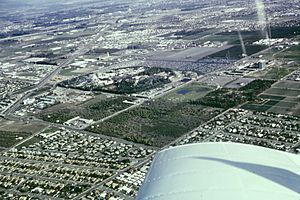
The area's warm Mediterranean climate and 42 miles (68 km) of year-round beaches attract millions of tourists annually. Huntington Beach is a hot spot for sunbathing and surfing; nicknamed "Surf City, U.S.A.", it is home to many surfing competitions. "The Wedge", at the tip of The Balboa Peninsula in Newport Beach, is one of the most famous body surfing spots in the world. Southern California surf culture is prominent in Orange County's beach cities.
Other tourist destinations include the theme parks Disneyland and Disney California Adventure Park in Anaheim and Knott's Berry Farm in Buena Park. Since the 2011 closure of Wild Rivers in Irvine, the county is home to just one water park: Soak City in Buena Park. The Anaheim Convention Center is the largest such facility on the West Coast. The old town area in the City of Orange (the traffic circle at the middle of Chapman Ave. at Glassell) still maintains its 1950s image, and appeared in the That Thing You Do! movie.
Little Saigon is another tourist destination, being home to the largest concentration of Vietnamese people outside of Vietnam. There are also sizable Taiwanese, Chinese, and Korean communities, particularly in western Orange County. This is evident in several Asian-influenced shopping centers in Asian American hubs like the city of Irvine.
Historical points of interest include Mission San Juan Capistrano, the renowned destination of migrating swallows. The Richard Nixon Presidential Library and Museum is in Yorba Linda and the Richard Nixon Birthplace home, located on the grounds of the Library, is a National Historic Landmark. John Wayne's yacht, the Wild Goose or USS YMS-328, is in Newport Beach. Other notable structures include the home of Madame Helena Modjeska, located in Modjeska Canyon on Santiago Creek; Ronald Reagan Federal Building and Courthouse in Santa Ana, the largest building in the county; the historic Balboa Pavilion in Newport Beach; and the Huntington Beach Pier. The county has nationally known centers of worship, such as Crystal Cathedral in Garden Grove, the largest house of worship in California; Saddleback Church in Lake Forest, one of the largest churches in the United States; and the Calvary Chapel.
Since the premiere in fall 2003 of the hit Fox series The O.C., and the 2007 Bravo series "The Real Housewives of Orange County" tourism has increased with travelers from across the globe hoping to see the sights seen in the shows.
Orange County has some of the most exclusive and expensive neighborhoods in the U.S., many along the Orange Coast, and some in north Orange County.
In popular culture
Orange County has been the setting for numerous written works and motion pictures, as well as a popular location for shooting motion pictures.
The city of San Juan Capistrano is the place where writer Johnston McCulley located the first novella about Zorro, entitled The Curse of Capistrano. It was published in 1919 and later renamed The Mark of Zorro.
Communities
Cities
- Aliso Viejo
- Anaheim
- Brea
- Buena Park
- Costa Mesa
- Cypress
- Dana Point
- Fountain Valley
- Fullerton
- Garden Grove
- Huntington Beach
- Irvine
- La Habra
- La Palma
- Laguna Beach
- Laguna Hills
- Laguna Niguel
- Laguna Woods
- Lake Forest
- Los Alamitos
- Mission Viejo
- Newport Beach
- Orange
- Placentia
- Rancho Santa Margarita
- San Clemente
- San Juan Capistrano
- Santa Ana (county seat)
- Seal Beach
- Stanton
- Tustin
- Villa Park
- Westminster
- Yorba Linda
Unincorporated communities
These communities are outside of city limits in unincorporated county territory.
Planned communities
Orange County has a history of large planned communities. Nearly 30 percent of the county was created as master planned communities, the most notable being the City of Irvine, Coto de Caza, Anaheim Hills, Tustin Ranch, Tustin Legacy, Ladera Ranch, Talega, Rancho Santa Margarita, and Mission Viejo. Irvine is often referred to as a model master-planned city because its villages of Woodbridge, Northwood, University Park, and Turtle Rock that were laid out by the Irvine Company of the mid-1960s before it was bought by a group of investors that included Donald Bren.
Population ranking
The population ranking of the following table is based on the 2010 census of Orange County.
† county seat
| Rank | City/Town/etc. | Municipal type | Population (2010 Census) |
|---|---|---|---|
| 1 | Anaheim | City | 336,265 |
| 2 | † Santa Ana | City | 324,528 |
| 3 | Irvine | City | 212,375 |
| 4 | Huntington Beach | City | 189,992 |
| 5 | Garden Grove | City | 170,883 |
| 6 | Orange | City | 136,416 |
| 7 | Fullerton | City | 135,161 |
| 8 | Costa Mesa | City | 109,960 |
| 9 | Mission Viejo | City | 93,305 |
| 10 | Westminster | City | 89,701 |
| 11 | Newport Beach | City | 85,186 |
| 12 | Buena Park | City | 80,530 |
| 13 | Lake Forest | City | 77,264 |
| 14 | Tustin | City | 75,540 |
| 15 | Yorba Linda | City | 64,234 |
| 16 | San Clemente | City | 63,522 |
| 17 | Laguna Niguel | City | 62,979 |
| 18 | La Habra | City | 60,239 |
| 19 | Fountain Valley | City | 55,313 |
| 20 | Placentia | City | 50,533 |
| 21 | Rancho Santa Margarita | City | 47,853 |
| 22 | Aliso Viejo | City | 47,823 |
| 23 | Cypress | City | 47,802 |
| 24 | Brea | City | 39,282 |
| 25 | Stanton | City | 38,186 |
| 26 | San Juan Capistrano | City | 34,953 |
| 27 | Dana Point | City | 33,351 |
| 28 | Laguna Hills | City | 30,344 |
| 29 | North Tustin | CDP | 24,917 |
| 30 | Seal Beach | City | 24,168 |
| 31 | Ladera Ranch | CDP | 22,980 |
| 32 | Laguna Beach | City | 22,723 |
| 33 | Laguna Woods | City | 16,192 |
| 34 | La Palma | City | 15,568 |
| 35 | Coto de Caza | CDP | 14,866 |
| 36 | Los Alamitos | City | 11,449 |
| 37 | Rossmoor | CDP | 10,244 |
| 38 | Midway City | CDP | 8,485 |
| 39 | Villa Park | City | 5,812 |
| 40 | Sunset Beach | CDP (annexed by city of Huntington Beach in 2011) | 971 |
| 41 | Las Flores | CDP | 5,971 |
Economy
Business
Orange County is the headquarters of many Fortune 500 companies including Ingram Micro (#62) and First American Corporation (#476) in Santa Ana, Broadcom (#150) in Irvine, Western Digital (#198) in Lake Forest, and Pacific Life (#269) in Newport Beach. Irvine is the home of numerous start-up companies and also is the home of Fortune 1000 headquarters for Allergan, Edwards Lifesciences, Epicor, and Sun Healthcare Group. Other Fortune 1000 companies in Orange County include Beckman Coulter in Brea, Quiksilver in Huntington Beach and Apria Healthcare Group in Lake Forest. Irvine is also the home of notable technology companies like TV and sound bar company VIZIO, router manufacturer Linksys, video/computer game creator Blizzard Entertainment, and in-flight product manufacturer Panasonic Avionics Corporation. Also, the prestigious Mercedes-Benz Classic Center USA is located in the City of Irvine. Many regional headquarters for international businesses reside in Orange County like Mazda, Toshiba, Toyota, Samsung, Kia, in the City of Irvine, Mitsubishi in the City of Cypress, Kawasaki Motors in Foothill Ranch, and Hyundai in the City of Fountain Valley. Fashion is another important industry to Orange County. Oakley, Inc. is headquartered in Lake Forest. Hurley International is headquartered in Costa Mesa. Both the network cyber security firm Milton Security Group and the shoe company Pleaser USA, Inc. are located in Fullerton. St. John is headquartered in Irvine. Tustin, is home to Ricoh Electronics, New American Funding, and Safmarine. Wet Seal is headquartered in Lake Forest. PacSun is headquartered in Anaheim. Restaurants such as Taco Bell, El Pollo Loco, In-N-Out Burger, Claim Jumper, Marie Callender's, Wienerschnitzel, have headquarters in the city of Irvine as well. Del Taco is headquartered in Lake Forest. Gaikai also has its headquarters in Orange County.
Shopping
Shopping in Orange County is centered around regional shopping malls, big box power centers and smaller strip malls. South Coast Plaza in Costa Mesa is the largest mall in California, the third largest in the United States, and 31st largest in the world. Other regional shopping malls include (from north to south): Brea Mall, The Village at Orange, The Outlets at Orange, MainPlace Santa Ana, Westminster Mall, Bella Terra in Huntington Beach, The Market Place straddling Tustin and Irvine, Irvine Spectrum Center, Fashion Island in Newport Beach, Five Lagunas and The Shops at Mission Viejo. Downtown Disney and Anaheim GardenWalk are specialized shopping and entertainment centers aimed at visitors. Power centers include La Habra Marketplace, Anaheim Plaza and Anaheim Town Square. There is one major outlet mall, The Outlets at San Clemente.
Tourism
Tourism remains a vital aspect of Orange County's economy. Anaheim is the main tourist hub, with the Disneyland Resort's Disneyland being the second most visited theme park in the world. Also, Knotts Berry Farm gets about 7 million visitors annually and is located in the city of Buena Park. The Anaheim Convention Center holds many major conventions throughout the year. Resorts within the Beach Cities receive visitors throughout the year due to their close proximity to the beach, biking paths, mountain hiking trails, golf courses, shopping and dining.
Food culture
As recently as the 1990s, award-winning restaurants in Orange County consisted mostly of national chain restaurants with traditional American or Tex-Mex comfort food. In the late 1990s, Tim and Liza Goodell with chef Florent Marneau, and David Wilhelm, established culinary restaurant groups featuring nouvelle cuisine, gourmet burgers and more. The Orange County Register states that the "tipping point" came in 2007 when Marneaus founded Marché Moderne (since moved to Crystal Cove), and Top Chef chef Amar Santana opened a branch of Charlie Palmer (closed 2015), both at South Coast Plaza. Santana followed opening restaurants Broadway in Laguna Beach and Vaca in Costa Mesa. Other Top Chef chefs followed with their own restaurants including Brian Huskey (Tackle Box), Shirley Chung (Twenty Eight), Jamie Gwen of Cutthroat Kitchen, and from The Great Food Truck Race, Jason Quinn (Playground), who also opened three stands at the 4th Street Market food hall in Downtown Santa Ana in 2016.
Food halls with gourmet vendors include the 42,000-square-foot (3,900 m2) Anaheim Packing District, the 4th Street Market in Downtown Santa Ana, Lot 579 in Huntington Beach, Trade Food Hall in Irvine, OC Mix in Costa Mesa, and The Source OC in Buena Park.
In 2019, the Michelin Guide awarded stars for the first time to Orange County restaurants, awarding Hana Re and Taco Maria each one star. In 2021, Knife Pleat in Costa Mesa was awarded one Michelin star as well.
Sports
Huntington Beach annually plays host to the U.S. Open of Surfing, AVP Pro Beach Volleyball and Vans World Championship of Skateboarding. It was also the shooting location for Pro Beach Hockey. USA Water Polo, Inc. has moved its headquarters to Irvine, California. Orange County's active outdoor culture is home to many surfers, skateboarders, mountain bikers, cyclists, climbers, hikers, kayaking, sailing and sand volleyball.
The Major League Baseball team in Orange County is the Los Angeles Angels. The team won the World Series under manager Mike Scioscia in 2002. In 2005, new owner Arte Moreno wanted to change the name to "Los Angeles Angels" in order to better tap into the Los Angeles media market, the second largest in the country. However, the standing agreement with the city of Anaheim demanded that they have "Anaheim" in the name, so they became the Los Angeles Angels of Anaheim. This name change was hotly disputed by the city of Anaheim, but the change stood and still stands today, which prompted a lawsuit by the city of Anaheim against Arte Moreno, won by the latter.
The county's National Hockey League team, the Anaheim Ducks, won the 2007 Stanley Cup beating the Ottawa Senators. They also came close to winning the 2003 Stanley Cup finals after losing in Game 7 against the New Jersey Devils.
The Toshiba Classic, the only PGA Champions Tour event in the area, is held each March at The Newport Beach Country Club. Past champions include Fred Couples (2010), Hale Irwin (1998 and 2002), Nick Price (2011), Bernhard Langer (2008) and Jay Haas (2007). The tournament benefits the Hoag Hospital Foundation and has raised over $16 million in its first 16 years.
Orange County SC is a United Soccer League team and are the only professional soccer club in Orange County. The team's first season was in 2011 and it was successful as Charlie Naimo's team made it to the quarter-finals of the playoffs. With home games played at Championship Soccer Stadium in Orange County Great Park the team looks to grow in the Orange County community and reach continued success. Former and current Orange County SC players include Richard Chaplow, Bright Dike, Maykel Galindo, Carlos Borja, and goalkeeper Amir Abedzadeh.
The National Football League left the county when the Los Angeles Rams relocated to St. Louis in 1995.
The National Basketball Association's Los Angeles Clippers played some home games at The Arrowhead Pond, now known as the Honda Center, from 1994 to 1999, before moving to Staples Center, which they share with the Los Angeles Lakers.
Education
Orange County is the home of many colleges and universities, including:
|
|
Some institutions not based in Orange County operate satellite campuses, including the University of Southern California, National University, Pepperdine University, and Springfield College.
The Orange County Department of Education oversees 28 school districts.
Images for kids
See also
 In Spanish: Condado de Orange (California) para niños
In Spanish: Condado de Orange (California) para niños


